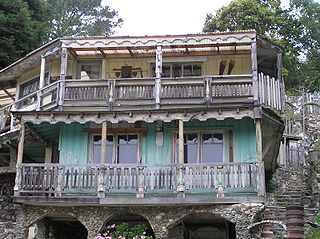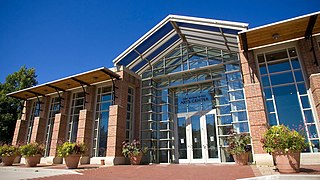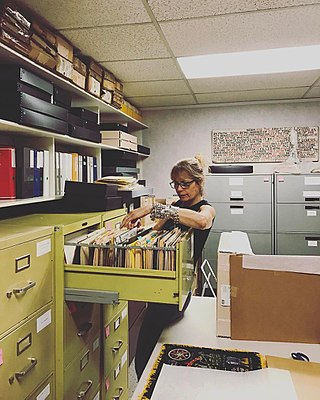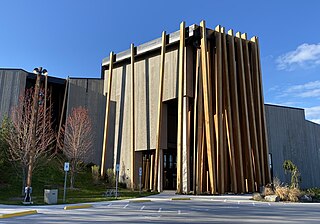Los Angeles Pierce College, shortened to Pierce College or simply Pierce, is a public community college in Woodland Hills, Los Angeles, California. It is part of the Los Angeles Community College District and is accredited by the Accrediting Commission for Community and Junior Colleges. It serves 22,000 students each semester.

The Watts Towers, Towers of Simon Rodia, or Nuestro Pueblo are a collection of 17 interconnected sculptural towers, architectural structures, and individual sculptural features and mosaics within the site of the artist's original residential property in Watts, Los Angeles, California, United States. The entire site of towers, structures, sculptures, pavement and walls were designed and built solely by Sabato Rodia, an Italian immigrant construction worker and tile mason, over a period of 33 years from 1921 to 1954. The tallest of the towers is 99.5 feet (30.3 m). The work is an example of outsider art and Italian-American naïve art.

Sun Valley is a neighborhood in Los Angeles, California in the San Fernando Valley region. The neighborhood is known for its overall youthful population and moderate racial diversity. There are three recreation centers in Sun Valley, one of which is a historic site. The neighborhood has thirteen public schools—including John H. Francis Polytechnic High School and Valley Oaks Center for Enriched Studies (VOCES)—and four private schools.

Nek Chand Saini was a self-taught Indian artist, known for building the Rock Garden of Chandigarh, an eighteen-acre sculpture garden in the city of Chandigarh.

Grandma Prisbrey's Bottle Village, also known as Bottle Village, is an art environment, located in Simi Valley, California. It was created by Tressa "Grandma" Prisbrey (1896–1988) from the 1950s to the 1970s. Prisbey built a "village" of shrines, walkways, sculptures, and buildings from recycled items and discards from the local landfill.

Trencadís, also known as pique assiette, broken tile mosaics, bits and pieces, memoryware, and shardware, is a type of mosaic made from cemented-together tile shards and broken chinaware. Glazed china tends to be preferred, and glass is sometimes mixed in as well, as are other small materials like buttons and shells. Artists working in this form may create random designs, pictorial scenes, geometric patterns, or a hybrid of any of these.

Nitt Witt Ridge is a house on two and a half acres in the coastal city of Cambria, California, United States. Artist and recluse Arthur "Art" Harold Beal (1896–1992) bought his hillside lot in 1928 and spent most of the next 50 years carving out the terraces with only a pick and shovel, creating his own "castle on a hill".

The John Michael Kohler Arts Center is an independent, not-for-profit contemporary art museum and performing arts complex located in Sheboygan, Wisconsin, United States. The center preserves and exhibits artist-built environments and contemporary art. In 2021, the center opened the Art Preserve, a satellite museum space dedicated to art environments.

William Blevins Tripp, is an American outsider artist, poet, writer, painter, welder, and sculptor, known primarily for his metal sculpture The Mindfield and his stream-of-consciousness autobiography novel, The Mindfield YearsVol. 1: The Sycamore Trees (1996).

A visionary environment or fantasy world is a large artistic installation, often on the scale of a building or sculpture parks, intended to express a vision of its creator. The subjective and personal nature of these projects often implies a marginal status for the artists involved, and there is a strong association between visionary environments and outsider art.
Annie Hooper was a sculptor of visionary religious art from Buxton, North Carolina. Her work is an example of folk art, outsider art, and visionary art.
Kea Tawana was an American artist known for creating the Ark, an 86-foot-long, three-story high ship she built in Newark, New Jersey, starting in 1982. For decades she had collected salvaged wood, stained glass, and other materials from abandoned buildings in the city's Central Ward, which had been hollowed out by poverty and riots in the late 1960s. She built the Ark on an empty lot; it was still unfinished when the city condemned it in 1987. Unable to find a new location, Tawana dismantled her ship in 1988. Tawana's Ark is classified as an example of visionary art and vernacular architecture.

Johannes Jacobus (Joop) Beljon was a Dutch artist, academy lecturer, director of academy and writer. As artist he was active as sculptor, fiber artist, lithographer, jeweler, environmental artists, and jewelry designer. Under the name J.J. Beljon and the pseudonym Bernard Majorick, Beljon was also writer. Beljon had taken over that pseudonym from the writer Godfried Bomans.
Sharron Quasius is an American sculptor.

Jo Farb Hernández is a folklorist, curator, and award-winning writer based in Watsonville, California and Catalunya, Spain. Succeeding founder Seymour Rosen as the second Executive Director of Saving and Preserving Arts and Cultural Environments, she helped develop the most extensive public archive on the subject of art environments in the world, and is recognized globally as one of the experts in the field.

Dr. Charles Smith is a visual artist, historian, activist and minister who lives and works in Hammond, Louisiana. His sculptural work focuses on African and African American history.

The Old Trapper's Lodge is a California Folk Art display started in 1951 in the United States. It was designated a California Historical Landmark on March 25, 1985. The Old Trapper's Lodge art work is located in Los Angeles Pierce College's Cleveland Park at 6201 Winnetka Avenue in Woodland Hills, Los Angeles in Los Angeles County. The folk art is a life-size sculpture made by John Ehn (1897-1981), a self-taught artist who loved Old West culture. Ehn used his family as models and turned them into life-size outsider art Old West characters.
The Philadelphia Folklore Project (PFP) is a non-profit organization advocating for and providing documentation, presentation, education, and collaborative research to folk and traditional arts across the Philadelphia region in service of social change. Founded in 1987 by folklorist Debora Kodish, PFP offers workshops and assistance to local artists and communities through organizing concerts, events, and exhibitions. Their driving philosophy is that "diversity and equity are central elements of thriving communities." One of a handful of independent folk and traditional arts nonprofits nationwide, the organization is widely regarded as a powerful instrument for socially conscious and anti-racist activism and serves as a model for sustaining living cultural heritage in the fields of applied folklore, ethnomusicology, and anthropology. It seeks to foster growth in communities through access to grant funding and artistic venues, but also material and social infrastructure in defense against gentrification and through cultivating positive inter-communal relationships.
Ruth DeYoung Kohler II was a museum director and teacher from Wisconsin who championed under-recognized, self-taught artists and vernacular art. She was the director of the John Michael Kohler Arts Center from 1972–2016. She led the development of the Art Preserve in Sheboygan, Wisconsin, the first museum dedicated to the exhibition and conservation of artist-built environments.

The Art Preserve is an art museum and a satellite campus of the John Michael Kohler Arts Center. The preserve houses a collection of artist-built environments and sculptural works. It is designed by Tres Birds and located in Sheboygan, Wisconsin. Opened in June 2021, the Art Preserve is the first museum dedicated to the exhibition, preservation, and care of artist-built environments. The museum also serves as a research space for the art environment genre.













